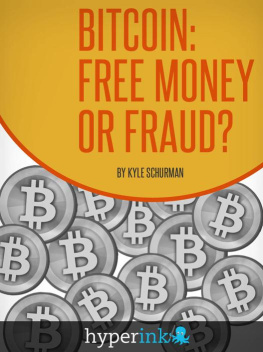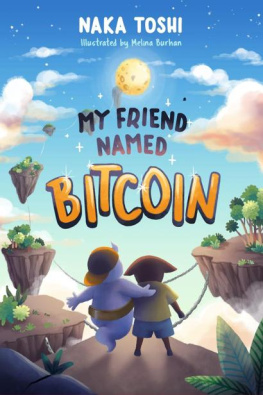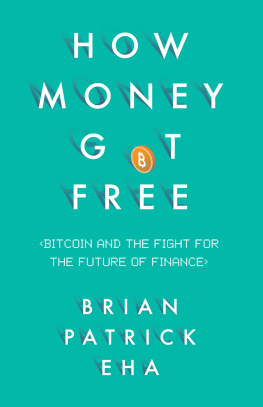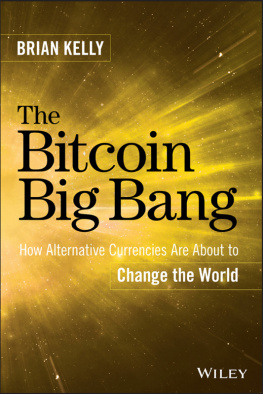Chapter 1: Introducing Bitcoin
Introducing Bitcoin
Bitcoin takes currency to a fully digital realm
Reach in your pocket or purse, and pull out the first bill you encounter. Maybe its a $100 bill. Maybe its $1. Regardless, take a good look. Ignore what youve maybe seen in movies like National Treasure , and think about what makes that bill valuable.
Ask yourself: why do we use dollar bills and coins to pay for goods and services?
Government backing makes money valuable. A government sets rules about what type of money is recognized as a method of trading for goods and services. Before the formation of monetary systems, people traded all sorts of goods for other items and services. For example: a farmer from colonial times might have traded some of his grain for a tool to make his work easier. Jump ahead a few hundred years and today were using bills, coins, and debit cards because theyre easier to carry than a bushel of corn.
In todays digital society, however, could people choose to not use traditional money? Could there be an all electronic currency without the backing of government? Has cryptography and our computational security advanced to the point that such a currency could be handled on a peer-to-peer basis with no third-party intervention?
In 2008, Satoshi Nakamoto wanted to find out. Nakamoto proposed the idea of the Bitcoin system, which is a form of digital currency, to other Internet users. All transactions could be completely anonymous , just like a cash transaction. No bank or paper money would be used.
Nakamotos idea is based on digital bartering. This system would allow people to trade bitcoins for goods and services. Instead of seeing farmers trade part of their crop for a new plow, Bitcoin takes the idea of currency to a fully digital realm .
Bitcoin uses cryptography and computer security to manage payment and removes third parties and central monetary authorities from the process. In the Bitcoin system, two parties simply agree to exchange bitcoins, thereby giving the digital currency its value.
No one really knows just how many people are using the Bitcoin system. This isnt surprising, seeing as how the system is completely anonymous. Bitcoin itself estimates as many as 60,000 people have used the system ( http://bitcoinstatus.rowit.co.uk/ ).
Whether Bitcoins current configuration f lows from Satoshi Nakamotos original vision is debatable. That said, theres little debate about whether Bitcoin has been successful. Its nothing short of a remarkable story about how one persons vision born of an Internet message board has developed into an international phenomenon .
Chapter 2: Making Use of Bitcoins
Making Use of Bitcoins
You can buy, sell, spend, and donate bitcoins
Once you have bitcoins in hand, what exactly can you do with them?
They actually work a lot like any other currency: you can buy, sell, spend, donate, exchange, or accumulate as many as youre able to.
When youre ready to sell or buy bitcoins, youll want to find a bitcoin exchange . These businesses deal in bitcoins, similar to how a business might buy and sell gold or silver. Most exchange Web sites tend to have a lot of introductory information on how to use bitcoins.
Many of these same businesses will also exchange bitcoins for cash . You should have few problems finding Web sites that offer these transactions in many different currencies. As with all currency exchanges, the market will dictate the value of a bitcoin versus any other currency. The Mt. Gox Web site ( https://mtgox.com/ ) is one of the most popular.
Finding local dealers to participate in face-to-face transactions can be challenging. Nevertheless, there are various Web sites that can help. One of the best is BTC Near Me ( http://btcnearme.com/ ), which allows you to search for buyers and sellers based on your zip code. You can also look on Facebook or Craigslist to find dealers who buy and sell bitcoins.
Some people choose to purchase bitcoins as an investment vehicle . Although their value against traditional currencies has fluctuated quite significantly over the past several months, theres a clear upward trend . Nevertheless, investing in bitcoins is much less systematic than investing in the stock market which should give you an idea of how risky it can be.
Many businesses have begun accepting bitcoins as payment. If you see a bitcoin accepted here logo on the Web site, that means youll be able to buy goods and services with bitcoins. On the Bitcoin Wiki site, about 650 merchants are listed who offer goods and services, many of which are related to Web design, online gaming, and apps. The Wiki site lists another 60 sites are related to trading and exchanging bitcoins. ( https://en.bitcoin.it/wiki/Trade )
Another area to find merchants who accept bitcoins is the Search Bitcoin Web site. The number of merchants who have signed on to the BItcoin system is minuscule compared to the total number of the merchants out there. And you cannot purchase every potential product you might want with bitcoins yet. But if bitcoins grow in popularity, the number of merchants accepting them will certainly grow.
(Image from Search Bitcoin, http://www.searchbitcoin.com/vendors/ )
You can also use your bitcoins for philanthropy . The donation process is made easy by the fact that you only need the charitys Bitcoin address. There is one downside, however: because of the Bitcoin systems anonymity, you might have some difficulty in claiming an income tax donation. A list of these charities is available on the Bitcoin Wiki site ( https://en.bitcoin.it/wiki/Donation-accepting_organizations_and_projects ).
Chapter 3: Basics of Bitcoin
Basics of Bitcoin
Physical coins are not needed
As suggested by the name, bitcoins are virtual coins consisting of bits, or digital data. A bit is the smallest piece of information that a computer uses to perform processes. In computer language, bits are combined to create commands and instructions for computer usage.
The beauty of Bitcoin is that physical coins are not needed. The Bitcoin system makes use of secure encryption to ensure each bitcoins authenticity. Their creation also requires a secure computing process which cant be easily corrupted. The entire systems outline for the security method to follow, public key encryption, has been public knowledge since its introduction.
Keep in mind that, without some sort of limitation to the method by which coins are created, bitcoins would have no value. Monetary systems based on a commodity money system issue paper currency and metal coins based on precious metals. For example, United States collection of gold, backed the U.S. dollar and the U.S. monetary system, followed this system until President Nixon suspended the directly convert dollars to gold in 1971. ( http://en.wikipedia.org/wiki/Gold_standard#Post-war_international_gold-dollar_standard_.281946.E2.80.931971.29 )
The key to such a system is limiting the amount of money that can be printed to the amount of gold thats available. With the Bitcoin system, the limitation is in the number of bitcoins. The system only can create a limited number of bitcoins over time, which helps give them value.
Ultimately, though, the value of bitcoins is determined by the people using them. As long as people want bitcoins and believe they have value, they will have a value. In a traditional monetary system, if people stop believing in the value of a government, the value of that countrys money will plummet. The same would occur with bitcoins, should people suddenly stop believing they have value.







![Brian Kelly [Brian Kelly] - The Bitcoin Big Bang: How Alternative Currencies Are About to Change the World](/uploads/posts/book/119681/thumbs/brian-kelly-brian-kelly-the-bitcoin-big-bang.jpg)


